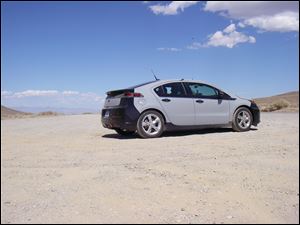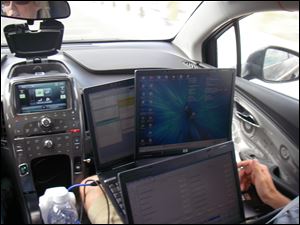
Bowling Green native's job is to push car until it breaks
3/10/2010
Trent Warnke and others in his team have driven the Chevrolet Vol thousands of miles in North America's most challenging environments, including Death Valley, Calif.
MILFORD, Mich. - As a teenager in the 1990s, Trent Warnke said he would stare at the posters on the wall of his bedroom in Bowling Green and dream of working on cars when he grew up.
Now the 28-year-old Wood County native works on one of the world's largest automotive playgrounds, on one of the world's most technologically advanced cars, with just one main goal - to break it.

A Chevy Volt in Death Valley, California.
Mr. Warnke, a 2000 graduate of Bowling Green High School, is part of a team of automotive engineers who have spent the last several years road-testing the Chevrolet Volt, an extended-range electric vehicle scheduled to make its debut in Chevy dealership showrooms in California this year.
"It's my job to make it break, figure out what broke, and then make sure we fix whatever issue came up before we get it in front of the consumer," Mr. Warnke said.
Considered one of General Motors Co.'s most important upcoming products, the Volt is an electric vehicle that is designed to drive up to 40 miles on electricity without using gasoline or producing tailpipe emissions.

Computers display information from test sensors on a Chevy Volt.
But when its lithium-ion battery is depleted, an onboard engine attached to a generator engages to extend the total driving range to about 300 miles. Production of the vehicle is to begin late this year in Michigan.
Although official pricing and production numbers have not yet been announced by GM, analysts believe the vehicle will retail for about $40,000. Initial production will be limited to a few thousand vehicles, but will rise to tens of thousands as demand increases, analysts say.
To make it break, Mr. Warnke has driven the Volt thousands of miles through the continent's most extreme conditions, from the bottom of Death Valley to the height of Pikes Peak in Colorado, to within a few hours' drive of the Arctic Circle.
Mr. Warnke, who lives in the Detroit suburb of Novi, works at GM's Milford Proving Ground, a 4,000-acre campus full of nondescript buildings, rolling, tree-filled hills, and miles and miles of roads of every shape and condition. The proving ground is about 30 miles northeast of Ann Arbor, near where U.S. 23 and I-96 intersect.
Although his title is officially development and validation engineer, he said his job is to identify everything that could go wrong with the Volt and fix it before it reaches the showroom floor.
Mr. Warnke may spend his days now behind the wheel - or behind a keyboard in the passenger seat running diagnostics while another engineer drives - but his automotive journey started with a fascination of what he calls "the most complicated product a consumer can buy."
"When I was a teenager, I really started to get into cars and learning more about them, learning how to work on them, and all that kind of stuff," he said. "I enjoyed working on them, so I thought about becoming a mechanic. But I had good math and science in high school, and my teachers there said that engineering would probably be a good field for me."
After graduating from high school, Mr. Warnke went to Kettering University - a GM college renowned for its emphasis on automotive engineering - to pursue a degree in engineering, with a specialty in powertrains. He co-opped at the time for GlassTech Inc., a glass-processing technology designer in Perrysburg, and worked at the company for a short time before moving to Germany.
There, he pursued a master's of engineering degree in a new field called mechatronics - the study of integrated mechanical-electrical devices - "which is very fitting for hybrids and electric cars," he said. He also worked at German auto parts conglomerate Bosch GmbH, before returning to Michigan and joining GM's Volt team about a year ago.
Mr. Warnke said his extended experience in GM's most technologically advanced production car makes him believe that the car-buying public will come to appreciate all the vehicle can do, just as he has.
He said that unlike "pure electric" competitors such as the Nissan Leaf and Mini E, the Volt doesn't suffer from range-killing efficiency losses to extreme heat or cold.
And unlike two-mode hybrids like the Toyota Prius, the Volt's 40-mile electric range will allow most consumers to cut visits to the gas pump down to an absolute minimum.
GM will deliver more than 100 Volt vehicles to several utilities beginning in 2010 - including DTE Energy - as part of an extended research and demonstration fleet program, a commercial extension of the kind of testing Mr. Warnke has done.
As part of the program, 500 charging stations will be installed for residential, business, and public use, the automaker said. They will be used to learn more about the installation process, vehicle charging, and to gain customer feedback.
Whether the Volt will be the first step toward a long-term solution for the nation's energy needs or just a stopgap measure as more advanced solutions are developed remains to be seen, Mr. Warnke said.
"It's going to be answered by battery technology and by what the customers want. It's a hard market out there," he said.
Contact Larry P. Vellequette at:
lvellequette@theblade.com
or 419-724-6091.